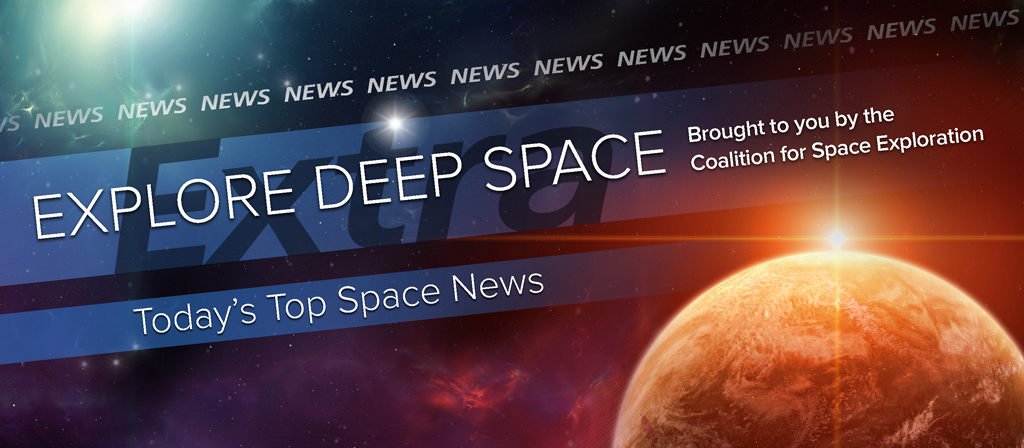Today’s Deep Space Extra offers the latest reporting and commentary on space related activities from across the globe. On Monday, NASA began accepting applications to the agency’s astronaut corps. Enthusiasm over new U.S. commercial space legislation granting U.S. citizens’ rights to resources extracted from planetary bodies may be premature. On Mars, NASA’s Curiosity rover has rolled to an expanse of sand dunes to continue its search for habitable environments. Astronomers may have found missing water in the atmospheres of ‘hot Jupiters’. Chile’s high tech observatories contend with advancing artificial light. December’s night skies feature Venus, the Moon and the comet Catalina. U.S., Russian and European astronauts lift off for the International Space Station early Tuesday. Warning signs of launch failures are often overlooked. The story behind “story time” from space. The U.S. aerospace and defense industry nurtures innovation, economic growth and life’s comforts. Ban on Russia’s RD-180 rocket engine likely not workable, according to an editorial.
Human Deep Space Exploration
NASA Want Ad: Astronauts Needed to Help Get to Mars
Associated Press via New York Times (12/14): NASA’s latest astronaut application period opened Monday and will close Feb. 18. Successful applicants will have opportunities to live and work aboard the International Space Station, launch on test missions in the new NASA Earth/moon proving ground and perhaps land on Mars.
Staking a claim to space resources
The Space Review (12/14): Essayist Jeff Foust notes the enthusiasm over recent passage of U.S. commercial space legislation, and in particular over a provision that grants U.S. citizens’ ownership rights to resources they extract from asteroids, the Moon and other planetary bodies. Will the ownership rights hold up to challenges lodged under the Outer Space Treaty? The answer may await a challenge to the first citizens who exercise the provisions. But can they succeed first in attracting investors? Foust examines the issue.
Unmanned Deep Space Exploration
Curiosity Reaches Massive Field of Spectacularly Ripple Active Martian Sand Dunes
Universe Today (12/14): Now at the base of Mount Sharp on Mars, NASA’s Curiosity rover has reached a vast expanse of sand dunes, the next phase of the rover’s search for habitable environments on the red planet. Curiosity has been exploring Gale Crater on Mars since its landing in August 2012.
Where’s the water? Telescopes team up to solve hot Jupiter mystery
Los Angeles Times (12/14): Observations of the largest planets beyond the solar system, the so called ‘hot Jupiters’ have long puzzled scientists who were not seeing anticipated evidence of water. Recent observations with the Hubble and Spitzer space telescopes, however, suggest the water is present but blocked from view by thick clouds.
In Chile, world’s astronomy hub, scientists fear loss of dark skies
Reuters (12/15): Astronomers fear their dark perch in the Andes Mountains of Chile has become polluted by the artificial lighting from civilization below.
The Moon, Venus And Comet Catalina Shine In Beautiful Space Photograph
The Huffington Post (12/14): December sky watchers have much to look at: bright Venus, the Moon and a new comet, Catalina.
Low Earth Orbit
Live coverage: Russian-American-British crew launches toward space station
Spaceflightnow.com (12/15): A Russian Soyuz rocket with cosmonaut Yuri Malenchenko, NASA’s Tim Kopra and the European Space Agency’s Tim Peake launched to the International Space Station from Kazakhstan on Tuesday at 6:03 a.m., EST. After safely reaching Earth orbit, the Soyuz TMA-19M spacecraft was on course to dock with the space station at 12:24 p.m., EST.
Launch failures: the predictables
The Space Review (12/14): A trail of launch vehicle failures and the investigations that followed lead to a common theme: pre-launch concerns that were overlooked. “The space launch business is far less forgiving of such an approach than most forms of endeavor, and usually provides earlier and more spectacular feedback,” writes essayist Wayne Eleazer, a retired U.S. Air Force launch vehicle program manager. “And in the event of a failure, perhaps the most important question is not ‘why did this occur?’ but ‘why did this fault slip by us?’
The former NASA educator who put a new spin on “`book launch”
Toronto Star, of Canada (12/13): Educator Patricia Tribe, fascinated by spaceflight, had an idea: encourage an astronaut to read a book on the topic penned for children as a means of interesting them in science and technology. NASA astronaut Alvin Drew agreed and so have others who live and work on the International Space Station.
Commercial to Orbit
Commentary: What’s Needed To Support Aerospace, Defense Breakthroughs
Defense News (12/13): The aerospace and defense industry is leading the way as a major contributor to U.S. innovation, economic growth and quality of life, writes Marillyn Hewson, Lockheed Martin chair, president and CEO, in an op-ed.
Like It or Not, Congress Will Have To Revisit RD-180 Ban
Space News (12/14): U.S. lawmakers have over reached in their restrictions of U.S. imports of Russia’s RD-180 rocket engine, Space News maintains in an editorial. Intended to punish Russia for its interference in Ukraine, the legislation instead could prevent U.S. national security agencies from gathering space based intelligence and performing other functions. The RD-180 powers the first stage of the United Launch Alliance Atlas 5, the launch vehicle that has placed most U.S. national security payloads in orbit. A domestic rocket engine alternative is likely six years away. In the meantime, ULA has elected not to bid on some U.S. Department of Defense missions.

